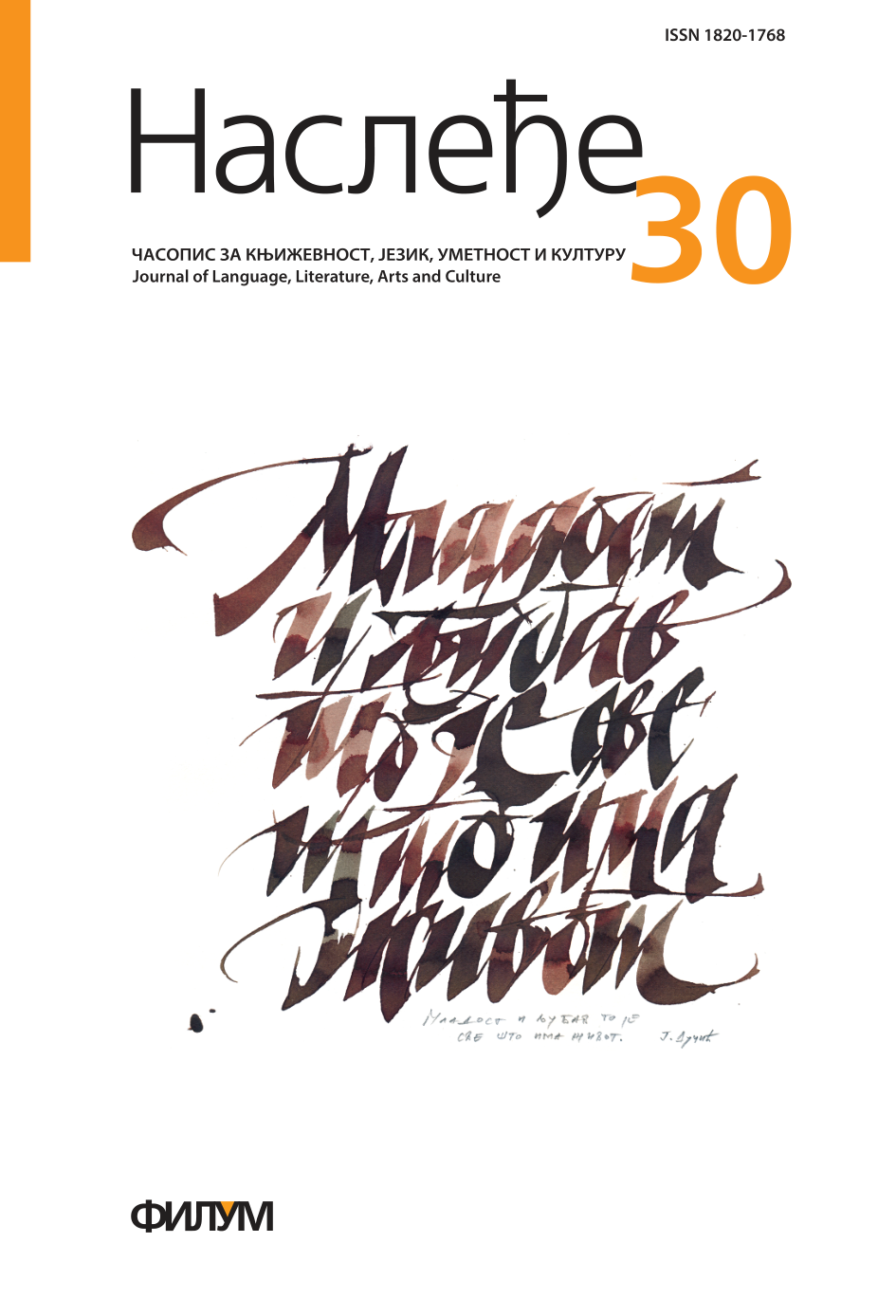THE DESIRE TO WRITE: ART AS A FIELD OF THE INSCRIPTION IN THE CONTEXT OF EXPLORING THE POTENTIAL OF A HYBRID AND WOMEN’S WRITING
Keywords:
desire, writing, art, author/authoress, hybrid writing, female writingAbstract
Working in the domains of text theory, gender studies, feminisms and platforms of theoretical psychoanalysis, this paper opens up several problems: the question of desire as a structural element and the effect of writing; the question of the field of art as a field that is open not only to the inscription of the dialogue which the creative subject performs in regard to the artistic context, but also of art as a field that challenges, enables and introduces the resignificational potential in the writing/language system, which is particularly prominent in hybrid and women’s writing; in the end, the text opens up the issues of the specific writing of the female author, as well as the possibilities of exploring the proactive potential of the women's writing which points towards the strategies of alteration, softening, dislocation and subversion of the hard, phallogocentric systems of writing.
References
Bart 1997: R. Barthes, The Death of the Author, u: Stephen Heath (red.), Image-MusicText, London: Fontana Press, 142-148.
Bart 1998: R. Barthes, The Pleasure of the Text, New York: Hill and Wang.
Brej 2004: A. Bray, Hélène Cixous – Writing and Sexual Difference, New York: Palgrave Macmillan.
Frojd 2000a: S. Freud, Five Lectures on Psychoanalysis (1910), Freud – Complete Works, El Paso: Ivan Smith, 2195-2239.
Frojd 2000b: S. Freud, The Claims of Psycho-analysis to Scientific Interest (1913), Freud – Complete Works, El Paso: Ivan Smith, 2800-2826.
Frojd 2000c: S. Freud, Some Psychical Consequences of the Anatomical Distinction Between the Sexes (1925), Freud – Complete Works, Freud – Complete Works, El Paso: Ivan Smith, 4144-4156.
Gros 1990: E. Grosz, Jacques Lacan – a Feminist Introduction, London: Routledge, 1990.
Gros 1994: E. Grosz, Volatile Bodies: Toward a Corporeal Feminism, Bloomington: Indiana University Press.
Homer 2005: S. Homer, Jacques Lacan, London: Routledge, 2005.
Kivima 2009: K. Kivimaa, Private Bodies or Politicized Gestures? Female Nude Imagery in Soviet Art, Gender Check – Femininity and Masculinity in the Art of Eastern Europe, Cologne: Museum Moderner Kunst Ludwig Wien, 114-119.
Kopdžek 1990: J. Copjec, The Ortopsychic Subject: Film Theory and the Reception of Lacan, October, 49, Cambridge: The MIT Press, 53-71.
Kristeva 1980: J. Kristeva, How Does One Speak to Literature, u: Leon S. Roudiez, Desire in Language – A Semiotic Approach to Literature and Art by Julia Kristeva, New York: Columbia University Press, 92-123.
Kristeva 1981: J. Kristeva, Women’s Time, Signs, Journal of Women in Culture and Society, 7/1, Chicago: The University of Chicago Press, 13-35.
Kristeva 1984: J. Kristeva, Revolution in Poetic Language, New York: Columbia University Press.
Majers 1992: D. T. Meyers, The Subversion of Women’s Agency in Psychoanalytic
Feminism: Chodorow, Flax, Kristeva, u: Nancy Fraser, Sandra Lee Bartky, Revaluing French Feminism – Critical Essays on Difference, Agency, and Culture, Bloomington:
Indiana University Press, 136-161.
Molsvort 2010: H. Molesworth, How to Install Art as a Feminist, u: Cornelia Butler, Alexandra Schwartz, Modern Women – Women Artists at the Museum of Modern Art, New York: The Museum of Modern Art, 499-513.
Malvi 1975: L. Mulvey, Visual Pleasure and the Narrative Cinema, Screen 16.3, 1975, 6-18.
Nikolčina 2000: M. Nikolčina, Igre stranaca – Julija Kristeva u utopijskoj perspektivi, R. E. Č. – Časopis za književnost, kulturu i društvena pitanja, 59/5, Beograd: Radio B92, 109-119.
Nohlin 1988: L. Nochlin, Linda, Why Have There Been No Great Women Artists? Women, Art, and Power – and Other Essays, New York: Harper & Row Publishers, 145-178.
Šuvaković 2006: M. Šuvaković, Studije slučaja – diskurzivna analiza izvođenja identiteta u umetničkim praksama, Pančevo: Mali Nemo






